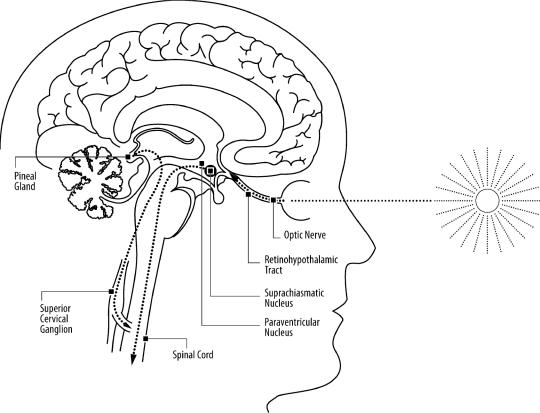Some drugs also target melatonin activity. Tasimelteon, for example, acts as a melatonin receptor agonist with affinity melatonin type 1 and type 2 receptors (MT1 and MT2) (15). Melatonin is a hormone released at night that has a role in maintenance of the circadian rhythm that regulates the normal sleep-wake cycle, and it is known that circadian melatonin rhythm is closely associated with the sleep rhythm (15, 16). Melatonin’s importance in sleep is still debated, but in mice MT1 receptor knockout was shown to result in less REM sleep, and MT2 knockout mice had a reduction in non-REM sleep, which suggest that melatonin has some role in regulating sleep (6).The central circadian clock which is located in the suprachiasmatic nuclei (SCN) of the hypothalamus induces night-state physiological functions, and melatonin is thought to attenuate the wake promoting signal of the circadian clock (Fig. 1). So, melatonin receptor agonists like tasimelteon are thought to promote sleep by acting of melatonin receptors in the SCN to reduce SCN-alerting signals and wakefulness-producing mechanisms (17).

Being the group that investigate on the relationship between melatonin and circadian rhythm, I think this a great summary on how melatonin regulate circadian rhythm and sleep cycle. I think it is very interesting to learn how Tasimelteon also bind to melatonin receptor! Since we are discussing about melatonin receptor, I think it is good to explain why you choose to discuss about Tasimelteon instead of melatonin. Moreover, I think a comparison between the structure of melatonin and Tasimelteon can justify such discussion.
Link our website!!!
This page does a good job providing a brief description of melatonin and its function in regulating sleep. As our group’s website is about melatonin, I think it would be interesting if we linked each other’s websites.
Just out of curiosity, people who take melatonin to aid in sleep often develop tolerances quickly. Does this happen with agonist drugs like Tasimelteon?
This is a good overview of melatonin and the receptors involved in the signaling pathways. You also do a good job of discussing the neural circuits that influence the melatonin signaling and its role in insomnia. I agree that a comparison of the structures of melatonin to Tasimelteon is useful here.
This page provides a nice, brief overview of how the melatonin receptors in the brain work. You could briefly discuss how Tasimelteon works or how it is similar/different from melatonin itself. I also like how you distinguished between the two types of melatonin receptors and how they appear to have different functions in REM/non-REM sleep
Tasimelteon mechanisms are very similar to melatonin. Due to the fact that it is an agonist of melatonin, we thought this was sufficient enough information, considering our primary goal was to explain melatonin and how agonists overall increase melatonin’s ability to promote sleep.
This is best section I have read so far, great work. I think you do an excellent job of explaining the possible role of melatonin as well as providing very relevant research papers. The only thing to add is a more thorough explanation of what melatonin is, even outside of the role on sleep.